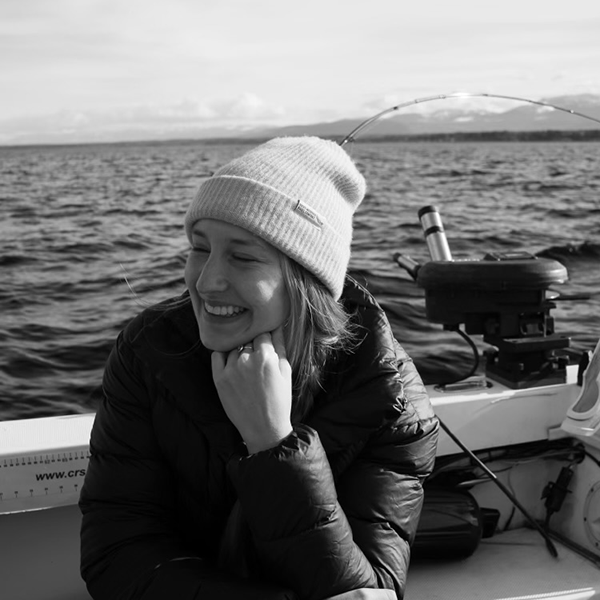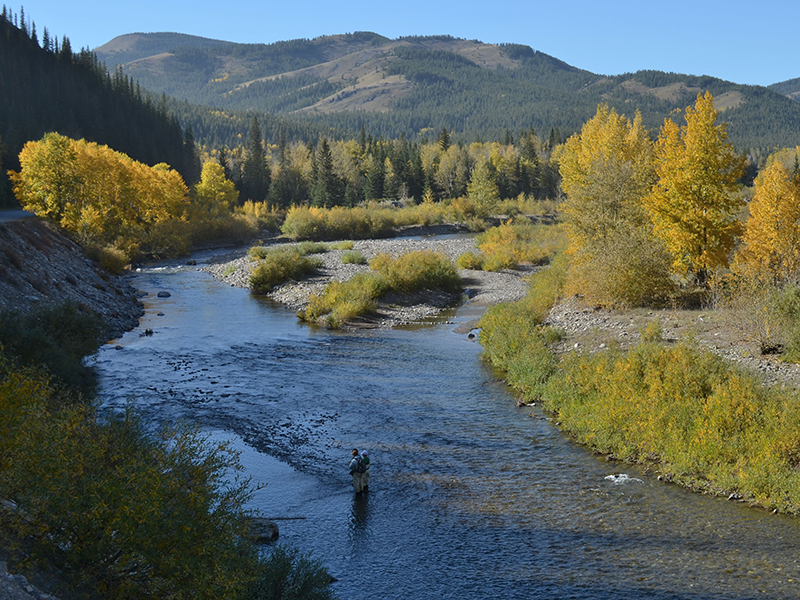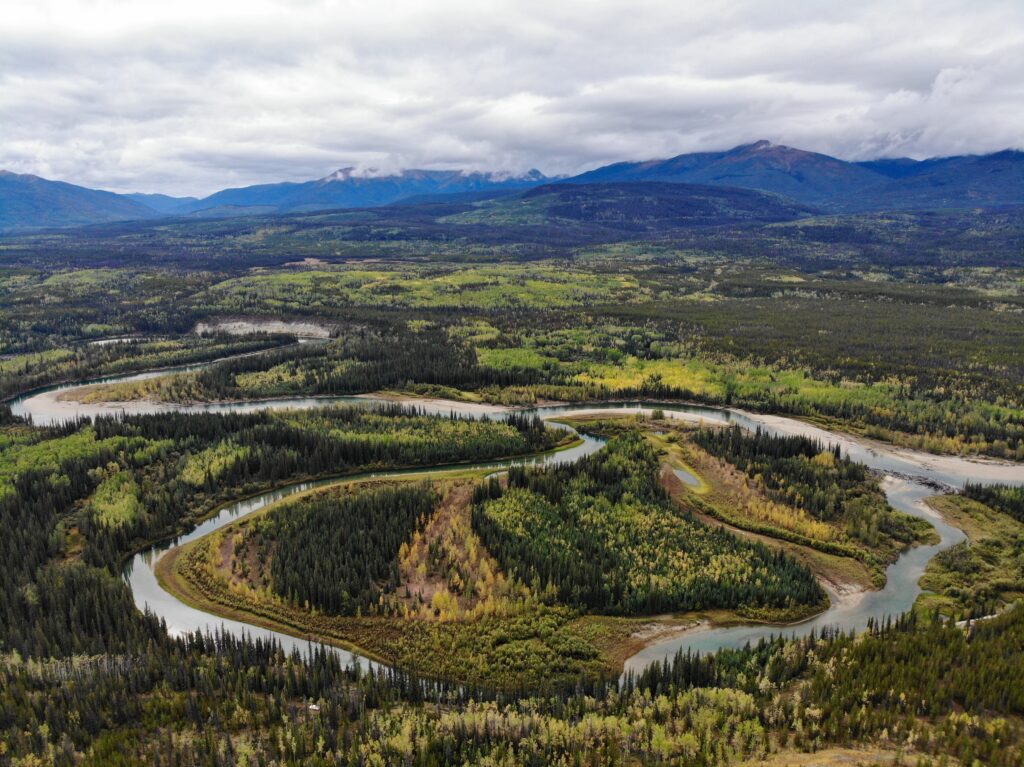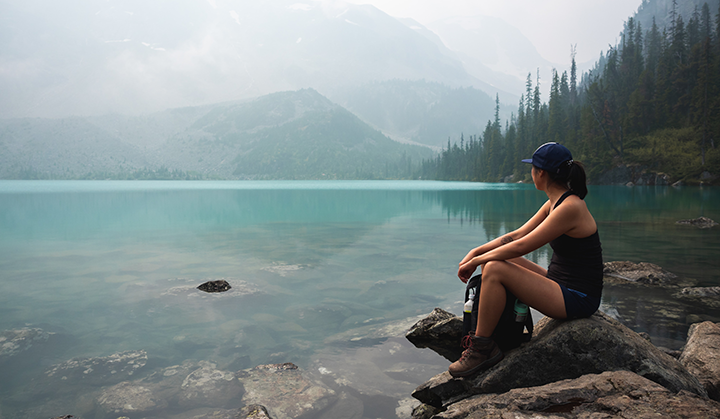Tenaya Lynx reflects on why Indigenous-led conservation and connected, protected landscapes are key to protecting life-giving water sources in the Yellowstone to Yukon region and beyond

Tenaya Lynx has returned to her hometown of Canmore, Alberta, after completing her Bachelor of Science in Geography degree at the University of Victoria. She is passionate about community connections, maintaining the integrity of natural systems, and exploring untapped possibilities within the conservation sector.
In the summer of 2020, Tenaya was Y2Y’s volunteer co-ordinator and worked with a group of volunteers to increase awareness on the Yellowstone to Yukon vision. In this guest post, Tenaya writes about the importance of protecting our precious water sources after attending the Global Water Futures Open Science Finale in May 2023.
Heat. Rain. Snow. Fires. It’s all happening here in the Yellowstone to Yukon region.
Rapid and more drastic changes in climate impact landscapes, wildlife and people. Climate change is one of the top drivers of biodiversity loss, while biodiversity loss makes ecosystems increasingly vulnerable to climate change — including life-giving water sources.
But after attending the Global Water Futures (GWF) Open Science Finale in Saskatoon, Saskatchewan in mid-May, I have learned more about why Indigenous-led conservation projects and large landscape conservation are key for water science and management.
As leaders in cold water science, GWF has published more than 2,000 scientific articles with much of their research focusing on the Rocky Mountains. Their Coldwater Research Lab is located in Canmore, led by the distinguished Dr. John Pomeroy.
Changes to mountain landscapes
We have hit multiple temperature records across the province of Alberta, with some cities, such as Calgary, seeing increases of 4.5 degrees Celsius over normal.
In my hometown of Canmore, people have been surprised by feverish weather in May, torrential rains in June, and now, summer snow. My community is noticing significant changes in our snow storage, water supply and sensitivity to fire.
Considering that snowpack started melting six weeks early this year, what does this mean for Albertans as we head into the summer months?
When our snowpack melts earlier than normal, ripple effects are felt downstream. Change in the Rockies means change everywhere.
“We’re having problems because we don’t listen to the water.”
Mistawasis Nêhiyawak Elder Anthony Blair Dreaver Johnston at the 2023 Global Water Futures Open Science Finale
Provincial headwaters regions — the Bighorn, Kananaskis, Ghost, Livingstone-Porcupine, and Castle — provide 90 percent of Alberta’s water, fueling our bodies, agricultural lands, and of course, all things wild.
The mountains act as year-round storage sites for freshwater. In the winter as snowpack and ice, and throughout the summer as glaciers. When these stores are drained prematurely and as glaciers diminish in size, it means that our rivers rely predominantly on groundwater and precipitation throughout the summer and fall. Despite the recent disappointment of cancelled camping trips and soggy bike rides, these summer rains will be instrumental in maintaining river flows this season.
How do we move forward in the face of climate extremes? As Mistawasis Nêhiyawak Elder Anthony Blair Dreaver Johnston put it so well at the GWF Conference, “We’re having problems because we don’t listen to the water.” Anthony is an Indigenous Mentor at the University of Saskatchewan’s School of Environment and Sustainability.

Large landscape conservation is a solution
Human development and activity in the Yellowstone to Yukon region, such as more roads, industrial development, recreation, and agriculture, has caused significant land-use changes. These changes affect the natural movement of water back into the ground.
Connecting and protecting the headwater regions is essential for maintaining some sort of natural water balance in the Bow Valley and beyond. Many glaciers in the Rockies such as those in Yoho, Jasper, and Banff National Parks have already been safeguarded. But there is still work to be done.
Connecting and protecting the headwater regions is essential for maintaining some sort of natural water balance in the Bow Valley and beyond.
To further demonstrate the positive impacts of large landscape conservation, the Nature Conservancy of Canada, one of Y2Y’s partners, has a plan to conserve more than 5,000 square kilometers (1,931 square miles) of prairie grasslands by 2030 to increase water storage and quality throughout Alberta, Saskatchewan, and Manitoba.
This project aims to build resiliency back into Canada’s prairies by reclaiming native grass species and wetlands. This restoration will increase groundwater levels and reduce vulnerability from changes to headwater flow.
Similarly, Y2Y’s collaborative Bees to Bears project in north Idaho focuses on forested wetland restoration. These ecosystems are dependent on seasonal floods and the vitality of the Kootenai River. Land-use changes have dramatically impacted these ecosystems and species sensitive to changes in temperature and moisture, such as the Western toad.
By listening to the needs of these species who live here, Y2Y and partners are using nature-based design, such as the creation of seasonal ponds and cool air refugia, to mitigate the impacts of water shortages and temperature change.
One of the main focuses of the GWF meeting was the decline of wetlands. Scholars from across Canada (Baulch et al., 2021; Jarvie et al., 2020) discussed the urgency of wetland protection and restoration in order to buffer landscapes from climate-related effects and to treat agricultural runoff, such as phosphorus.
The main message from numerous studies was that localized efforts as part of a greater water governance framework are necessary for the comeback of wetlands.
Indigenous knowledge and practices for healthy waterways
Increasingly, people are realizing the importance of including Indigenous knowledge and planning to keep our precious water sources healthy.
Unfortunately, current governance frameworks are counterproductive to Indigenous sovereignty and practices through their legacy of colonization.
For water to flourish, Indigenous communities across the Yellowstone to Yukon region must also have room (and funding) to flourish.
For water to flourish, Indigenous communities across the Yellowstone to Yukon region must also have room (and funding) to flourish.
Indigenous Protected and Conserved Areas (IPCAs), Traditional Land Technicians, and other such Indigenous-led groups are mobilizing traditional knowledge and science to inform decision-making.
Many folks, including myself, feel that profound spiritual relationships with the land and water are lacking in Western science. A more holistic (and effective) approach would include both methodologies.
Dawn Martin Hill of the Mohawk Wolf Clan and co-founder of McMaster University’s Indigenous Studies program says mutual respect and substantial funding are needed for Indigenous communities to support land-based education and to raise awareness.

Listen to the water
In the end, we are all responsible for protecting the lands and waters that we depend on. We have the science and local observations to tell us that conditions are changing rapidly in the Rockies and beyond. Extreme weather events have many of us worried but also more motivated than ever to pursue and support long-lasting solutions.
It is for this reason that I find hope in Y2Y’s work. They are steadfast in supporting large landscape conservation projects in addition to calls to action from Indigenous Knowledge holders and from Western science. It is all of us together that will make a difference for our water.
So go sit by the water. Take a dip or let the symphony of birds and amphibians lull you to sleep.
I just know that if we go near the water, we will come to think of this precious liquid as family and begin to see it everywhere — in the sky, in the ground and in ourselves. Our science and water management would certainly change for the better if water was considered a relative opposed to resource.
Just go. Listen.


